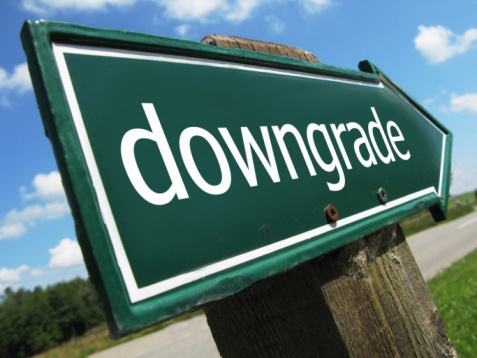Since late March, the Dow Jones Transports have begun struggling and underperforming the industrials in a pattern of lower highs and lower lows, resulting in a classic Dow theory non-confirmation. That non-confirmation could turn into a Dow theory sell signal if the industrials start to form a pattern of lower highs in the next two months while the transports continue their downward chug.
Stuck in the midst of the downturn in transports are the major airline stocks. Southwest Airlines Co. (NYSE: LUV) took a hit Thursday morning after Barclays analyst David Fintzen lowered the stock’s rating from Overweight to Underweight, slashing the price target from $50 to $39. By the end of the day, investors brushed off the call and shares remained unchanged for the day.
Barclays also downgraded American Airlines Group Inc. (NASDAQ: AAL) to underweight and a target of $58, which is still a 45% increase from current prices, while Delta Air Lines Inc. (NYSE: DAL) has received a target of $61 in the short term by 12 analysts, with JPMorgan maintaining an Overweight rating for the airline. That is a 47% expected rise from current share price. Southwest got the short end of the deal here, with a price target only 16% higher than the most recent closing price.
Does Southwest really deserve the downgrade relative to its peers? Fintzen’s report focuses primarily on routes and city targets, saying Southwest will not be able to effectively transition from its current dominant markets of short flights in mid-tier cities to longer routes in major metropolitan areas. Well maybe, maybe not, but counterbalancing that is the fact that Southwest still has the safest and arguably one of the wisest financing strategies in the industry.
ALSO READ: 6 Analyst Stocks With 50% to 100% Upside Calls
The biggest expense for any airline is jet fuel, and Southwest is very efficient at locking in low fuel rates by using derivative hedges. This doesn’t always work to its advantage. During the recent oil price decline, Southwest was unable to take advantage of the full brunt of savings that falling oil prices gave the airline industry, with fuel costs down only 33% year over year in first quarter, compared with American’s 43% drop in fuel costs. But the reason for that is Southwest’s hedging, because by buying derivative contracts against higher prices, you lose if prices fall. Southwest lost $47 million on those contracts in 2015.
And yet, those hedges have been unwound as oil has bottomed, locking in current low jet fuel costs for the airline going forward to 2016 with 1.28 billion gallons (page 8) hedged at current prices, almost a year’s worth of fuel. Meaning, any upsurge in jet fuel prices over the next year will not be felt relative to competitors. Meanwhile, its first-quarter earnings were 40% of all of 2014’s, which were themselves record setting for the company. 2015 has gotten off to a great start, and it could get even better if jet fuel prices go back up. That would allow Southwest to undercut its competition, not having to spend extra on fuel.
A rise in fuel prices certainly will be felt by Southwest’s competition though, particularly American Airlines. While American benefited from collapsing jet fuel prices much more than Southwest, that is because American does not hedge at all, leaving its margins at the mercy of the commodity markets. As of now, both stocks are down about the same over the past three months with the rest of the transports, but when oil bounces back up, that could change.
ALSO READ: 4 Merrill Lynch High Quality and Dividend Yield Stocks to Buy Now
On the balance sheet side, Southwest outperforms American easily as well. Debt to equity for American is a high 68%, much of it subject to floating rates, while Southwest’s is only 12%.
There are other anomalies with American that seem to be the result of sloppy financial decisions as well. The airline has $640 million in nominal investments in Venezuelan Bolivars, the only country currently undergoing bona fide hyperinflation. That money is likely stuck there and is only nominally $640 million due to government set exchange rates that cannot actually be realized. This spells significant impairment, and probably fairly soon.
Delta is somewhere in the middle between Southwest and American, and while it does hedge, it is not as efficient at it as Southwest has been. Fuel costs dropped only 18% in the first quarter year over year due to a $411 million fuel hedge loss. The oil plunge took it by surprise it seems, though Delta is also in a position to benefit from rising fuel prices, just as Southwest is.
So in the end, to downgrade Southwest but keep a 45% higher price target for American seems mistaken. Zooming out though, the transports as a whole need to start recovering before any of these targets can even get close to being reached, and for that to happen the global financial picture needs to clear up. Right now it is still very cloudy.
ALSO READ: Airbus Adds 100 to New Plane Orders to Win Paris Air Show Race
Take Charge of Your Retirement In Just A Few Minutes (Sponsor)
Retirement planning doesn’t have to feel overwhelming. The key is finding expert guidance—and SmartAsset’s simple quiz makes it easier than ever for you to connect with a vetted financial advisor.
Here’s how it works:
- Answer a Few Simple Questions. Tell us a bit about your goals and preferences—it only takes a few minutes!
- Get Matched with Vetted Advisors Our smart tool matches you with up to three pre-screened, vetted advisors who serve your area and are held to a fiduciary standard to act in your best interests. Click here to begin
- Choose Your Fit Review their profiles, schedule an introductory call (or meet in person), and select the advisor who feel is right for you.
Why wait? Start building the retirement you’ve always dreamed of. Click here to get started today!
Thank you for reading! Have some feedback for us?
Contact the 24/7 Wall St. editorial team.


